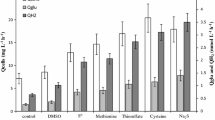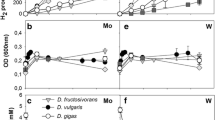Abstract
Desulfovibrio vulgaris (Marburg) was grown on H2 plus sulfate and H2 plus thiosulfate as the sole energy sources and acetate plus CO2 as the sole carbon sources. Conditions are described under which the bacteria grew exponentially. Specific growth rates (μ) and molar growth yields (Y) at different pH were determined.
μ and Y were found to be strongly dependent on the pH. Highest growth rates and molar growth yields were observed for growth on H2 plus sulfate at pH 6.5 (μ=0.15h-1; Y SO 2-4 =8.3g·mol-1) and for growth on H2 plus thiosulfate at pH 6.8 (μ=0.21h-1; Y S 2O 23 =16.9g·mol-1).
The growth yields were found to increase with increasing growth rates: plots of 1/Y versus 1/μ were linear. Via extrapolation to infinite growth rates a Y 2-SO4 /max of 12.2g·mol-1 and a YS2O 2-3 /max of 33.5g·mol-1 was obtained.
The growth yield data are interpred to indicate that dissimilatory sulfate reduction to sulfide is associated with a net synthesis of 1 mol of ATP and that near to 3 mol of ATP are formed during dissimilatory sulfite reduction to sulfide.
Similar content being viewed by others
References
Andrew, I. G., Morris, J. G.: The biosynthesis of alanin by Clostridium kluyveri. Biochim. Biophys. Acta 97, 176–179 (1965)
Badziong, W., Thauer, R. K., Zeikus J. G.: Isolation and characterization of Desulfovibrio growing on hydrogen plus sulfate as the sole energy source. Arch. Micribiol. 116 41–49 (1978)
Barton, L. L., LeGall, J., Peck. H. D., Jr.: Oxidative phosphorylation in the obligate anaerobe, Desulfovibrio gigas. In: Horizons of bioenergetics (A. San Pietro, H. Gest, eds.), pp. 33–51, New York: Academic Press 1972
Bray, G. A.: A simple efficient liquid scintillator for counting equeous solutions in a liquid scintillation counter. Analyt. Biochem. 1, 279–285 (1960)
Brenchley, J. E., Prival, M., Magasanik, B.: Regulation of the synthesis of enzymes responsible for glutamate formation in Klebsiella aerogenes. J. Biol. Chem. 248, 6122–6128 (1973)
Decker, K., Jungermann, K., Thauer, R. K.: Energy production in anaerobic organisms. Agew. Chem. Int. Ed. Engl. 9, 138–158 (1970)
Gunsalus, I. C., Shuster, C. W.: Energy-yielding metabolism in bacteria. In: The bacteria (I. C. Gunsalus, R. Y. Stanier, eds.) pp. 1–58. New York: Academic Press 1961
Haschke, R. H., Campbell, L. L.: Thiosulfate reductase of Desulfovibrio vulgaris. J. Bacteriol. 106, 603–607 (1971)
Haschikian, E. C.: Purification and properties of thiosulfate reductase from Desulfovibrio gigas. Arch. Microbiol. 105, 249–256 (1975)
Hatchikian, E. C., Chaigneau, M., LeGall, J.: Analysis of gas production by growing cultures of three species of sulfatereducing bacteria. In: Proc. Symp. Microbial Production and Utilization of Gases (H2, CH4, CO) H. G. Schlegel, G. Gottschalk, N. Pfennig, eds.), pp. 109–118. Göttingen: Goltze 1976
Hungate, R. E.: A roll tube method for cultivation of strict anaerobes. In: Methods in microbiology, Vol. 3 B (J. R. Norris, D. W. Ribbons, eds.), pp. 117–132: London-New York: Academic Press 1969
Ishimoto, M., Fujimoto, D.: Adenosine-5′ phosphosulfonate as an intermediate in the reduction of sulfate by a sulfate-reducing bacterium. Proc. Jpn. Acad. Sci. 35, 243–245 (1959)
Khosrovi, B., Mac Pherson, R., Miller, J. D. A.: Some observations on growth and hydrogen uptake by Desulfovibrio vulgaris. Arch. Microbiol. 80, 324–337 (1974)
King, T. E., Morris, R. O.: Determination of acid-labile sulfide and sulfhydryl groups. In: Methods in enzymology, Vol. 10 (S. P. Colowik, N. O. Kaplan eds.) pp. 634–641. New York: Academic Press 1967
Le Gall, J., Postgate, J. R.: The physiology of sulfate-reducing bacteria. Adv. Microbiol. Physiol. 10, 81–133 (1973)
Luria, S. E.: The bacterial protoplasm: composition and organization. In: The bacteria, Vol. 1 (I. C. Gunsalus, R. Y. Stanier, eds.), pp. 1–34. New York: Academic Press 1960
Nakatsukasa, W., Akagi, J. M.: Thiosulfate reductase isolated from Desulfotomaculum nigrificans. J. Bacteriol. 98, 429–433 (1969)
Pankhurst, E. S.: The isolation and enumeration of sulphatereducing bacteria. In: Isolation of anaerobes (D. A. Shapton, R. G. Board. eds.), pp. 223–240. New York: Academic Press 1971
Peck, H. D.: The ATP-dependent reduction of sulfate with hydrogen in extracts of Desulfovibrio desulfuricans. Proc. Natl. Acad. Sci. U.S.A. 45, 701–708 (1959)
Peck, H. D., Jr.: The role of adenosine-5′-phosphosulfate in the reduction of sulfate to sulfite by Desulfovibrio desulfuricans. J. Biol. Chem. 237, 198–203 (1962)
Pirt, S. J.: The maintenance energy of bacteria in growing cultures. Proc. Roy. Soc. London 163B, 224–231 (1965)
Postgate, J. R.: Media for sulfur bacteria. Lab. Practice 15, 1239–1244 (1966)
Postgate, J. R.: Media for sulfur bacteria: Some amendments. Lab. Practice. 18, 286 (1969)
Reeves, R. E.: How useful is the energy in inorganic pyrophosphate? TIBS 1, 53–55 (1976)
Senez, J. C.: Some considerations on the energetics of bacterial growth. Bacteriol. Rev. 26, 95–107 (1962)
Siegel, L. M.: Biochemistry of the sulfur cycle. In: Metabolic pathways, Vol. 7 (D. M. Greenberg, ed.), pp. 217–286. New York: Academic Press 1975
Sorokin, Yu. I.: Sources of energy and carbon for biosynthesis in sulfate-reducing bacteria [Engl. Transl.]. Microbiology (USSR) 35, 643–647 (1966a)
Sorokin, Yu. I.: Investigations of the structural metabolism of sulfate-reducing bacteria with 14C [Engl. Transl.]. Microbiogy (USSR) 35, 806–814 (1966b)
Sorokin, Yu. I.: Role of carbon dioxide and acetate in the biosynthesis by sulphate-reducing bacteria. Nature 210, 551–552 (1966c)
Stouthamer, A. H.: A theoretical study on the amount of ATP required for synthesis of microbial cell material. Antonie van Leeuwenhoek. J. Microbiol. Serol. 39, 545–565 (1973)
Stouthamer, A. H.: Yield studies in microorganisms. Durham, England: Meadowfield Press 1976
Stouthamer, A. H., Bettenhaussen, C.: Utilization of energy for growth and maintenance in continuous and batch cultures of microorganisms. Biochim. Biophys. Acta 301, 53–70 (1973)
Thauer, R. K., Jungermann, K., Decker, K.: Energy conservation in chemothrophic anaerobic bacteria. Bacteriol Rev. 41, 100–180 (1977)
Tomlinson, N.: Carbon dioxide and acetate utilization by Clostridium kluyveri. II. Synthesis of amino acids. J. Biol. Chem. 209, 597–603 (1954)
Tomlinson, N., Barker, H. A.: Carbon dioxide and acetate utilisation by Clostridium kluyveri. I. Influence of nutritional conditions on utilisation patterns. J. Biol. Chem. 209, 585–595 (1954)
van Uden, N.: Kinetics of nutrient-limited growth. Annu. Rev. Microbiol. 23, 473–486 (1969)
Vosjan, J. H.: ATP generation by electron transport in Desulfovibrio desulfuricans. Antonie van Leeuwenhoek J. Microbiol. Serol. 36, 584–586 (1970)
Vosjan, J. H.: Respiration and fermentation of the sulphate-reducing bacterium Desulfovibrio desulfuricans in a continuous culture. Plant and Soil 43, 141–152 (1975)
Ware, D. A., Postgate, J. R.: Physiological and chemical properties of a reductant-activated inorganic pyrophosphatase from Desulfovibrio desulfuricans. J. Gen. Microbiol. 67, 145–160 (1971)
Widdel, F., Pfennig, N.: A new anaerobic, sporing, acetate-oxidizing sulfate-reducing bacterium, Desulfotomaculum (emend.) acetoxidans. Arch. Microbiol. 112, 119–122 (1977)
Author information
Authors and Affiliations
Rights and permissions
About this article
Cite this article
Badziong, W., Thauer, R.K. Growth yields and growth rates of Desulfovibrio vulgaris (Marburg) growing on hydrogen plus sulfate and hydrogen plus thiosulfate as the sole energy sources. Arch. Microbiol. 117, 209–214 (1978). https://doi.org/10.1007/BF00402310
Received:
Issue Date:
DOI: https://doi.org/10.1007/BF00402310




